Sidebar
Jingszo !
 www.universetoday.com
www.universetoday.com
If you are going to look for intelligent life beyond Earth, there are few better candidates than the TRAPPIST-1 star system. The study began with a few assumptions. The biggest one was to presume that if TRAPPIST-1 has an intelligent civilization it is likely spread across more than one world. Given how compact the system is, that isn’t too outlandish. Getting from one world to another wouldn’t be much more difficult than it is for us to get to the Moon. With that assumption, the team then assumed that the worlds would transmit radio messages between each other. Since the signals would need to transverse interplanetary distances, they would be the strongest and most clear technosignatures in the system. So the team focused on signals during a planet-planet occultation (PPO). That is when two planets line up from our vantage point. During a PPO any signal sent from the far planet to the closer planet would spill over and eventually reach us. With 28 hours of observation data in hand, the team filtered out more than 11,000 candidate signals. Signals that were stronger than the expected range for natural signals. Then using computer models of the system they determined 7 possible PPO events and further narrowed things down to about 2,200 potential signals occurring during a PPO window. From there they went on to determine whether any of those signals were statistically unusual enough to suggest an intelligent origin. The answer to that was sadly no. Alas, if there are aliens in the TRAPPIST-1 system, we haven’t found them yet. But the result shouldn’t minimize this study. It is the longest continuous survey of the system to date, which is pretty cool. And it’s kind of amazing that we’ve reached the point where we’re able to do this study. We are actively searching known exoplanets in detail.
 menafn.com
menafn.com
The U.S. Senate Armed Services Committee is gearing up to hold a significant hearing focused on enhancing the credibility of the Pentagon's office dedicated to investigating unidentified flying objects (UFOs). This initiative comes as part of ongoing efforts to provide transparency and build public trust in the government's approach to unidentified aerial phenomena (UAP). The announcement of the hearing follows closely on the heels of a recent viral video showing a “huge UFO” adorned with numerous blinking and spinning lights, captured in Choteau, Montana, located less than 100 kilometers from the Malmstrom Air Force Base, a critical nuclear missile facility. This sighting has reignited public interest and debate surrounding UFOs, making the forthcoming congressional hearing even more timely and relevant.
 phys.org
phys.org
Astronomers have spotted the biggest pair of black hole jets ever seen, spanning 23 million light-years in total length. That's equivalent to lining up 140 Milky Way galaxies back to back. "This pair is not just the size of a solar system, or a Milky Way; we are talking about 140 Milky Way diameters in total," says Martijn Oei, a Caltech postdoctoral scholar and lead author of a Nature paper reporting the findings. "The Milky Way would be a little dot in these two giant eruptions." The jet megastructure, nicknamed Porphyrion after a giant in Greek mythology, dates to a time when our universe was 6.3 billion years old, or less than half its present age of 13.8 billion years. These fierce outflows—with a total power output equivalent to trillions of suns—shoot out from above and below a supermassive black hole at the heart of a remote galaxy.
 phys.org
phys.org
A research team, including academics from the University of Warwick, has suggested that apes can understand the communicative goals behind each other's actions—a skill previously thought to be unique to humans. Ever since Jane Goodall first observed apes gesturing to each other in the 1960s, researchers have debated how great apes like chimpanzees and gorillas communicate. Full Paper :- **The origin of great ape gestural forms** [https://onlinelibrary.wiley.com/doi/full/10.1111/brv.13136](https://onlinelibrary.wiley.com/doi/full/10.1111/brv.13136)
**Highlights** - Discovery of immunoglobulins in permafrost paleontology samples. - Allergens (plant’s metabolites, volatile organic compounds, pollen) induced sex contact inhibition as one of factor animals extinction. - Disruption of chemical signaling between animals as a factor in animal extinction. The influence of plants and parasites on signaling disruption between animals. One of the possible mechanisms for the extinction of animals during climate change could be a violation of the sense of smell due to the development of allergies when the flora changes. During the breeding season, susceptibility to odors is very important for animals. The development of allergies from plant pollen, changes in pollen's allergic toxicity, pollen's release period increasing or the emergence of a large quantity of flowering plants during climate change, could lead to decrements in sensitivity to odors in animals during the breeding season. This may explain the extinction of animals due to a decrease in sexual intercourse. Probably these changes in allergic responses of mammoths at period of climate changes led to a decrease in the mammoth population and, as a result, to their disappearance.
**Highlights** - Cats were tested for their body-awareness with incrementally decreasing openings - Cats did not make a priori decisions when they approached tall, narrow openings - However, cats hesitated to approach and enter uncomfortably short apertures - Trial-and-error or body-awareness are both ecologically valid strategies for cats Ecological validity ought to be considered as the gold standard in ethological research. The modular concept of self-representation in nonhuman animal species has led to several discoveries where researchers showed that particular components of representing the self can provide advantages to various animals in specific contexts (e.g., mirror self-recognition in cleaning fish; “body as an obstacle” in elephants; body size awareness in bumblebees. The results of this study have shown that cats did not react with a priori hesitation when they approached very narrow apertures that were smaller than the cat’s corresponding chest width. Compared to dogs’ reactions, this implies that for cats, body size awareness could have smaller relevance as a mental mechanism when they solve specific aperture tasks. Cats are mammals with well-developed complex cognition, who have to negotiate various and often dynamic obstacles in their three-dimensional spatial environment. This strengthens the likelihood that cats should possess probably even multiple forms of body awareness (size, shape, and weight).
 theconversation.com
theconversation.com
Black holes are mysterious objects – there’s a lot we don’t know about them. One longstanding question has been whether rotating black holes, which are so powerful they drag space-time along with them, could be used as an energy source. The physicist Roger Penrose suggested that, if an object fell into a rotating black hole in such a way that it split – with one part escaping – the part that left should effectively gain energy from the black hole. So if we sent objects or light towards a rotating black hole, we may be able to get energy back. It’s difficult to directly prove all this, however. But we have recently published our second study, in Nature Communications, experimentally verifying a more general theory behind it. This theory concerns all rotating objects that can absorb matter or radiation, and a black hole is, in essence, just a very big and effective absorber. The idea dates back to 1971 and the Soviet physicist Yakov Zel’dovich. Generalising Penrose’s idea, he predicted something very simple. If you take a cylinder that absorbs energy from waves, and you spin it, then it should actually spend its own energy to amplify some waves (boosting their energy).
 link.springer.com
link.springer.com
Two knights died during the life of Jamestown’s second church (ca.1617 to ca.1639). One was Sir Thomas West (The Lord De La Warr), the colony’s first resident governor. He died in 1618 on the transatlantic voyage to Jamestown and was buried there. There is no archaeological or historical evidence connecting the knight’s tombstone to Sir Thomas West. The other knight was governor Sir George Yeardley. The tombstone likely belonged to Yeardley based on a reference to it in the 1680s will of his step-grandson, Adam Thorowgood II. Thorowgood requested that his own black “marble” tombstone be engraved with the crest of Sir George Yeardley and have the same inscription found on “the broken tomb,” indicating that the stone was originally damaged in the seventeenth century as seen in the oldest photograph from 1905. Assuming the knight’s tombstone was George Yeardley’s, then it is the oldest black “marble” tombstone in the Chesapeake Bay region, USA and may be the oldest surviving tombstone in America . It is the only known tombstone in the English colonies with engraved monumental brass inlays.
 arstechnica.com
arstechnica.com
Origins of Hounds and Jackals, aka Fifty-Eight Holes, may lie in Asia rather than Egypt. An ancient board game known as Hounds and Jackals has long been believed to have originated in Egypt. However, according to a paper published in the European Journal of Archaeology, a version of the game board found in present-day Azerbaijan might date back even earlier, suggesting that the game originated in Asia. As previously reported, there is archaeological evidence for various kinds of board games from all over the world dating back millennia: Senet and Mehen in ancient Egypt, for example, or a strategy game called ludus latrunculorum ("game of mercenaries") favored by Roman legions. A 4,000-year-old board discovered last year at an archaeological site in Oman's Qumayrah Valley might be a precursor to an ancient Middle Eastern game known as the Royal Game of Ur (or the Game of Twenty Squares), a two-player game that may have been one of the precursors to backgammon (or was replaced in popularity by backgammon). Like backgammon, it's essentially a race game in which players compete to see who can move all their pieces along the board before their opponent. Last year, archaeologists discovered a 500-year-old game board in the ruins of Ćmielów Castle in Poland. It was a two-person strategy board game called Mill, also known as Nine Men's Morris, Merels, or "cowboy checkers" in North America. The earliest-known Mill game board was found carved into the roofing slabs of an Egyptian temple at Kurna, which likely predates the Common Era. Historians believe it was well-known to the Romans, who may have learned of the game through trade routes. Similar boards have also been found carved into cloister seats at English cathedrals Full Paper:- **Herding with the Hounds: The Game of Fifty-eight Holes in the Abşeron Peninsula** [https://www.cambridge.org/core/journals/european-journal-of-archaeology/article/herding-with-the-hounds-the-game-of-fiftyeight-holes-in-the-abseron-peninsula/3D308A06C1EED64BF5BB185B9DCCFBA1](https://www.cambridge.org/core/journals/european-journal-of-archaeology/article/herding-with-the-hounds-the-game-of-fiftyeight-holes-in-the-abseron-peninsula/3D308A06C1EED64BF5BB185B9DCCFBA1)
 arstechnica.com
arstechnica.com
A massive wave of pager explosions across Lebanon and Syria around 3:30 pm local time today has killed at least eight people and injured more than 2,700, according to local officials. Many of the injured appear to be Hezbollah members, although a young girl is said to be among the dead. The pagers in question allegedly have lithium-ion batteries, which sometimes explode after generating significant heat. The coordinated nature of the attack suggests that some kind of firmware hack or supply chain attack may have given an adversary the ability to trigger a pager explosion at the time of its choosing. Update, 1:05pm: The WSJ quotes regional security analyst Michael Horowitz as suggesting the attack was likely caused by either 1) malware triggering the batteries to overheat/explode or 2) an actual explosive charge inserted in the devices at some point in the supply chain and then detonated remotely. “Either way, this is a very sophisticated attack,” Horowitz told the WSJ. “Particularly if this is a physical breach, as this would mean Israel has access to the producer of those devices. This may be part of the message being sent here.”
 science.nasa.gov
science.nasa.gov
With the help of NASA's Hubble Space Telescope, an international team of researchers led by scientists in the Department of Astronomy at Stockholm University has found more black holes in the early universe than has previously been reported. The new result can help scientists understand how supermassive black holes were created. Currently, scientists do not have a complete picture of how the first black holes formed not long after the big bang. It is known that supermassive black holes, that can weigh more than a billion suns, exist at the center of several galaxies less than a billion years after the big bang. The new observational results suggest that some black holes likely formed by the collapse of massive, pristine stars during the first billion years of cosmic time. These types of stars can only exist at very early times in the universe, because later-generation stars are polluted by the remnants of stars that have already lived and died. Other alternatives for black hole formation include collapsing gas clouds, mergers of stars in massive clusters, and "primordial" black holes that formed (by physically speculative mechanisms) in the first few seconds after the big bang. With this new information about black hole formation, more accurate models of galaxy formation can be constructed.
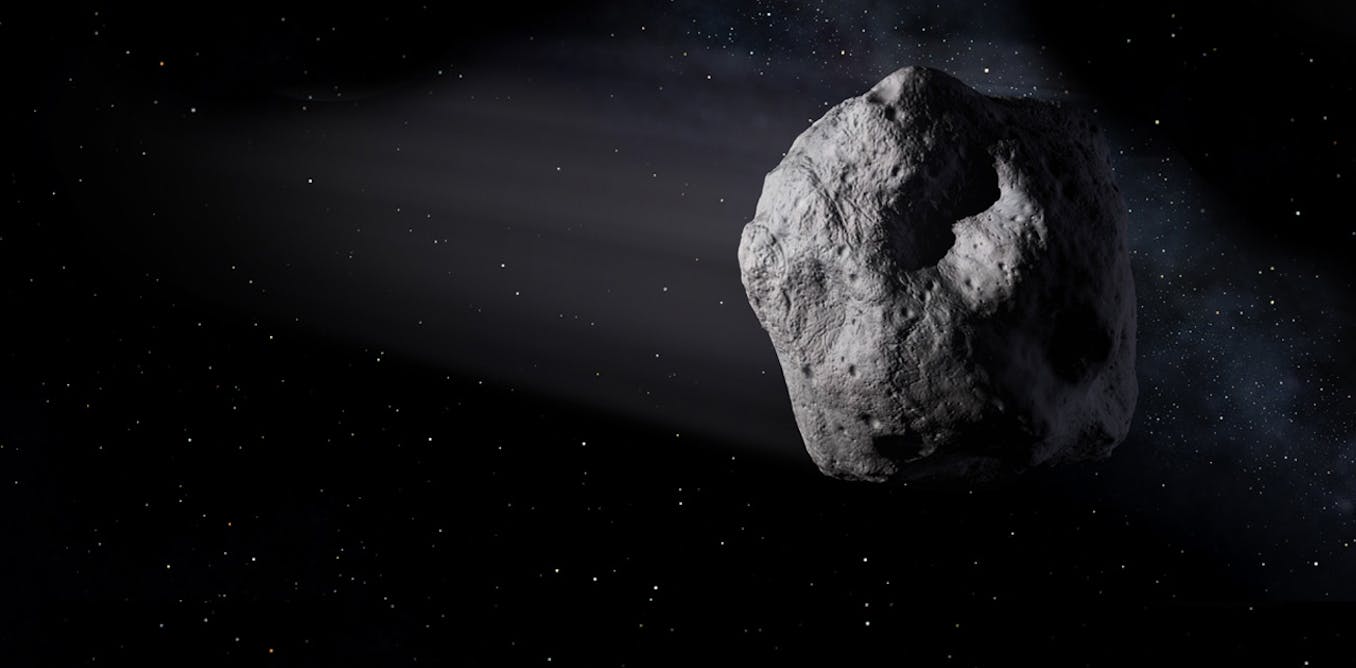 theconversation.com
theconversation.com
Asteroid impacts have influenced every large body in the solar system. They shape their appearance, alter their chemical abundance and – in the case of our own planet at the very least – they helped kickstart the formation of life. But these same events can also disrupt ecosystems, wiping out life, as they did 66 million years ago when a 10km space rock contributed to the extinction of the dinosaurs (excluding birds). Asteroids are the material left over from the formation of our solar system, that was not incorporated into planets and moons. They come in all shapes and sizes. Their paths are determined by gravity and can, to some extent, be predicted. Of particular interest are the objects that are close to Earth’s orbit – called near-Earth objects (NEOs). As of Sep 2024, we know of approximately 36,000 such objects, ranging in size from several metres to a few kilometres. But statistical models predict nearly 1 billion such objects should exist and we only know of very few of them. Asteroids less than 25m in diameter generally burn up before they can cause any damage. But objects of 25-1,000 metres in diameter are large enough to get through our atmosphere and cause localised damage. The extent of this damage depends upon the properties of the object and the area where it will hit. But an asteroid of 140 metres in size could cause widespread destruction if it hit a city. Luckily, collisions with asteroids in this size range are less frequent than for smaller objects. A 140 metre diameter object should hit Earth every 2,000 years. Asteroids larger than 1 kilometre in size have the ability to cause damage on a global scale, similar to the one that helped to wipe out the dinosaurs. These asteroids are much rarer but easier to spot. Since 2011, we think we have detected 98% of these objects. Less comforting is the fact that we have no current realistic proposal for diverting its path – though missions like Dart are a start.
 theconversation.com
theconversation.com
New Zealand is part of the larger continent of Zealandia, which finished separating from the supercontinent Gondwana some 57 million years ago. Some familiar animals were likely present in proto-New Zealand at this time, including our unique silent frogs, the ancient tuatara and many invertebrates. Tens of millions of years of dispersal of both plants and animals followed. Moa are most closely related to the flying chicken-sized tinamous from South America, and kiwi are relatives of the giant extinct elephant birds from Madagascar. Indeed, Australia did not even exist as a discrete entity 50 to 60 million years ago; it was still firmly affixed to Antarctica and South America. Exactly what routes the ancestors of moa and kiwi took to reach Zealandia remains unknown. They were part of a group of flying birds with a worldwide distribution called Lithornids, which lost flight many times independently and evolved into the ratites we know today. **The bones will speak** The St Bathans fossil deposit has given us an indispensable window into prehistoric New Zealand, and in many ways it is familiar – the bones of moa, kiwi, parrots, wrens and bats provide a reassuring continuity. As the publication notes, though, there are also many strange things in the fossil deposit – crocodiles, a relative of flamingos and a giant turtle. There’s an Alice in Wonderland quality to St Bathans, and it’s a crucial piece of the story of Aotearoa New Zealand’s biological heritage.
 phys.org
phys.org
In a new study, MIT physicists propose that if most of the dark matter in the universe is made up of microscopic primordial black holes—an idea first proposed in the 1970s—then these gravitational dwarfs should zoom through our solar system at least once per decade. A flyby like this, the researchers predict, would introduce a wobble into Mars' orbit, to a degree that today's technology could actually detect. Such a detection could lend support to the idea that primordial black holes are a primary source of dark matter throughout the universe. **Beyond particles** Less than 20% of all physical matter is made from visible stuff, from stars and planets, to the kitchen sink. The rest is composed of dark matter, a hypothetical form of matter that is invisible across the entire electromagnetic spectrum yet is thought to pervade the universe and exert a gravitational force large enough to affect the motion of stars and galaxies.
 www.straitstimes.com
www.straitstimes.com
LIMA - The Peruvian authorities said on Sept 16 they had seized about 1.3 tonnes of illegally harvested shark fins, a delicacy in some Asian countries that has placed the predatory creatures at grave risk. Harvesting often involves catching sharks, removing their fins, and tossing them back into the ocean to die. According to the Pew Environment Group, between 63 million and 273 million sharks are killed every year, mainly for their fins and other parts. AFP
 techxplore.com
techxplore.com
A flexible screen inspired in part by squid can store and display encrypted images like a computer—using magnetic fields rather than electronics. It's one of the first times where mechanical materials use magnetic fields for system-level encryption, information processing and computing. And unlike some earlier mechanical computers, this device can wrap around your wrist. Full Paper:- **Janus Swarm Metamaterials for Information Display, Memory, and Encryption** [https://onlinelibrary.wiley.com/doi/10.1002/adma.202406149](https://onlinelibrary.wiley.com/doi/10.1002/adma.202406149)
 newspaceeconomy.ca
newspaceeconomy.ca
Messaging to Extraterrestrial Intelligence (METI), also known as Active Search for Extraterrestrial Intelligence (SETI), is an approach that involves broadcasting intentional signals into space in the hope that an alien civilization might detect and respond to them. This strategy differs from passive SETI, which focuses on listening for signals rather than transmitting them. While the potential benefits of METI are profound, so too are the potential risks. This article provides an objective review of its pros and cons. Alerting Hostile Civilizations The primary argument against METI stems from concerns about the safety and security of our civilization. Critics, including renowned physicist Stephen Hawking, have warned that sending signals into space might alert advanced, potentially hostile, alien civilizations to our existence, which could pose an existential risk to humanity. The Premature Messaging Argument Some critics argue that we might be too technologically immature to start sending messages to potentially far more advanced civilizations. They suggest that we should wait until we have a better understanding of the universe and potential extraterrestrial civilizations before we start broadcasting our presence.
*For many decades, the coca plant—the main ingredient in cocaine—has been grown almost exclusively in South America. But a new study shows that nearly half of northern Central America appears to be highly suitable for cultivating this lucrative cash crop.* We assess how much of Central America is likely to be agriculturally suitable for cultivating coca (Erythroxylum spp), the main ingredient in cocaine. Since 2017, organized criminal groups (not smallholders) have been establishing coca plantations in Central America for cocaine production. This has broken South America's long monopoly on coca leaf production for the global cocaine trade and raised concerns about future expansion in the isthmus. Yet it is not clear how much of Central America has suitable biophysical characteristics for a crop domesticated in, and long associated with the Andean region. Biophysical factors, then, are unlikely to constrain coca's spread in northern Central America. Whether or not the crop is more widely planted will depend on complex and multi-scalar social, economic, and political factors. Among them is whether Central American countries and their allies will continue to prioritize militarized approaches to the drug trade through coca eradication and drug interdiction, which are likely to induce further expansion, not contain it. Novel approaches to the drug trade will be required to avert this outcome.
 www.popularmechanics.com
www.popularmechanics.com
The specimen raised eyebrows because it appeared capable of causing levitation. As Earthlings, we’re curious about whether alien civilizations like ours are out there or if they exist at all—which is why scientists were intrigued when a mysterious shard of metal exhibited signs that it might have come from intelligent minds on a distant planet. This peculiar specimen fell to Earth around 1947 in a supposed UFO wreck that seemed linked to the infamous Roswell incident, which had members of the general public believing a flying saucer had crashed to Earth. It turned out that the debris found in Roswell was actually from a U.S. Air Force balloon meant to spy on Soviet nuclear experiments. While we still don’t know exactly where on Earth the mysterious sample came from, all indications show that it belongs to our own planet. There is a likely origin story behind this object—it might be a product of post-WWII magnesium alloy research for lighter and stronger aircraft. Back then, magnesium alloys were poorly understood, according to the report. Maybe this artifact wasn’t part of a larger piece of technology manufactured by alien hands, or whatever appendages and machines they might use. Still, this was a valuable exercise, because ruling out objects that originated on Earth only gives us a better idea of what really could be extraterrestrial.
 www.nature.com
www.nature.com
The high evolvability of the mammalian ear is surprising: Nowhere else in the skeleton are different functional units so close together; it includes the smallest bones of the skeleton, encapsulated within the densest bone. We suggest that this evolvability is a direct consequence of the increased genetic and developmental complexity of the mammalian ear compared to other vertebrates. Some of the most spectacular macroevolutionary changes in the vertebrate ear – responsible for balance, posture, gaze stabilisation, and hearing – occurred in mammals. The transformation of jaw bones into the middle ear ossicles, which evolved at least three times independently in mammals, greatly increased the bandwidth of hearing. This increase in evolvability may have facilitated the evolution of different hearing adaptations in the auditory system of the middle and inner ear, as well as locomotor adaptations in the vestibular system through its integration with the auditory system. Ultimately, this enhanced evolvability may have contributed to the evolution of the spectacular disparity in mammalian body plans and ecological niches.
 www.thecollector.com
www.thecollector.com
The Vikings are seeing a renaissance in popular culture, appearing in movies, television series, and video games alike — but what did they really look like? Generally, the Viking Age is understood to have lasted between the 8th and the 11th centuries. “Viking” was the name given to the raiders from Scandinavia who plagued the nations around the North Sea and beyond. Technically, the term “Viking” refers to an occupation, rather than a culture: those going “Viking” were simply going raiding. However, the term has expanded to encapsulate not just the cultures around Scandinavia but also their colonies and raiding grounds in Britain, Ireland, the North Sea, and continental Europe. The Vikings also conquered land in Normandy, Ireland, and Scotland, and they traded and raided into Russia, the Byzantine Empire, and further into Asia. The central pillar of the Vikings’ success was their longboats. These clever crafts featured a sharp bow, with a wide, shallow midsection, allowing the sailors to traverse rivers and the bitter storms of the North Sea alike. What we think of as the “Vikings” incorporated a diverse group of peasant farmers, fishermen, traders, warriors, and kings — much the same as other cultures in the Early Medieval Period. Cloth was expensive and time-intensive to produce in the Early Middle Ages, and, as such, most people would not have more than one or two sets of clothes. The choice of material of most individuals in Scandinavia and across Europe was wool and linen; generally, linen would be worn as an undergarment and wool on top for added warmth. Archaeology and depictions from this period show that all classes of people loved to wear brightly colored clothing adorned with embroidered patterns and braids — bright blues, shades of green and yellow, and deep reds were all achievable with natural dyes like woad, nettle, and madder. The staple of Viking male clothing was the tunic. This was a loose-fitting garment that reached down to the knees and was secured at the waist with a belt and at the neck with a brooch. Artwork seems to show all classes and roles in society tended to wear this basic garment and wool was the perfect fabric of choice for the chilly, North Sea climate. It seems likely that there was very little variation in this style across Western Europe in the Early Middle Ages In contrast, Viking women’s costumes seem to have been more distinctive. In contrast to the ankle-length tunics of Anglo-Saxon women, Scandinavian women tended to wear “apron dresses.” These consisted of fabric wrapped around the torso with shoulder straps, secured with two brooches on the chest.
 phys.org
phys.org
Dr. Jill Mollenhauer argues that the Gulf Lowland Olmec, one of Mesoamerica's earliest major civilizations, sometimes incorporated aesthetic and ritual practices associated with their rock art into their sculptures. She argues that this allowed Olmec elites to harness the spiritual and natural potency of the wild and sacred landscape and bring it into the domestic and urban centers, where it legitimized their political power. Rock art and sculpture are distinct forms of art. While rock art is made in situ (original position), sculptures were quarried and brought in from different areas. In fact, because very few suitable stones exist within the local environment, large volcanic blocks had to be imported from far away. Olmec rock art is inherently linked to the landscape in which it was made, demarcating the inherent sacredness of the landscape. Often found along travel routes, caves, and rocky hillsides, it was linked to the wild and the dangerous, often demarcating the sacred homes of spiritual forces.
 arstechnica.com
arstechnica.com
Scientists measured scaling of the brush strokes to arrive at their conclusions. Vincent van Gogh's most famous painting is The Starry Night (1889), created (along with several other masterpieces) during the artist's stay at an asylum in Arles following his breakdown in December 1888. Where some have seen the swirling vortices of the night sky depicted in Starry Night as a reflection of van Gogh's own inner turmoil, physicists often see a masterful depiction of atmospheric turbulence. According to a new paper published in the journal Physics of Fluids, the illusion of movement in van Gogh's blue sky is also due to the scale of the paint strokes—a second kind of "hidden turbulence" at the microscale that diffuses throughout the entire canvas. This is yet more evidence that van Gogh had an exquisitely fine-tuned intuitive sense of turbulence, and he captured it beautifully in Starry Night. There may also be implications for fluid dynamics. “Turbulence is believed to be one of the intrinsic properties of high Reynolds flows dominated by inertia, but recently, turbulence-like phenomena have been reported for different types of flow systems at a wide range of spatial scales, with low Reynolds numbers where viscosity is more dominant,” Huang said. “It seems it is time to propose a new definition of turbulence to embrace more situations.”
 www.scientificamerican.com
www.scientificamerican.com
We can’t yet tell how life got its start on Earth. That’s one great reason to keep looking for life elsewhere Before we can even crudely estimate the likelihood of life beyond Earth, we need to know a lot more about how life on Earth got started. Take, for example, the notion that life on Earth emerged out of something called a “primordial soup”—a fluid mix of organic compounds that contained the necessary ingredients for biology. This idea became popular after a famous 1952 experiment by chemists Stanley Miller and Harold Urey, in which the researchers exposed a simple mixture of gases to an electrical spark discharge, and showed they could produce molecules closely related to amino acids. The trial seemed to reproduce a way in which life on Earth might have started. However, a closer examination of their results reveals those sparks created tiny amounts of thousands of different chemicals. Yet more recent research shows that what is really needed for the construction of both RNA (which is responsible for the storage of operational instructions and of information that must be passed on from one generation to the next) and amino acids (the building blocks of proteins) is high concentrations of a just a few key chemicals.
 bigthink.com
bigthink.com
It would get rid of our hazardous, radioactive, and pollutive waste for good, but physics tells us it’s a losing strategy for elimination. - With more humans than ever (over 8 billion) on Earth, the amount of waste we cumulatively produce on an annual basis continues to rise and rise: a problem that’s getting worse with time. - Much of that waste is hazardous, some of it is radioactive, and all of it needs to be kept out of food and water supplies. Environmentally, there’s no 100% safe place to put it. - Periodically, people suggest that we launch our waste into the Sun, destroying it forever while keeping Earth clean and pristine. But this is something we must never do, and physics explains why. How should we eliminate the worst of these offensive waste products? Some have suggested burying them in a geological subduction zone, where plate tectonics would eventually carry them into Earth’s mantle. Others recommend encasing them in concrete and allowing them to gradually degrade. Still others propose burying them in a geologically stable region, where they shall remain until future humans are ready to deal with them. All of these proposed solutions have pros and cons, but are worthy of consideration. However, what we mustn’t do is the frequently suggested: - pack them onto a rocket, - launch them into space, - and set on a collision course with the Sun, where they won’t plague Earth ever again. (Yes, if you were mining the depths of your memory, this was indeed the plot of Superman IV.) Even if our launch failure rate were reduced to an unprecedented 1-in-1000, we’d still anticipate dozens of tons of hazardous waste winding up in our oceans and over our planet’s continents: an unacceptable catastrophe for our environment.
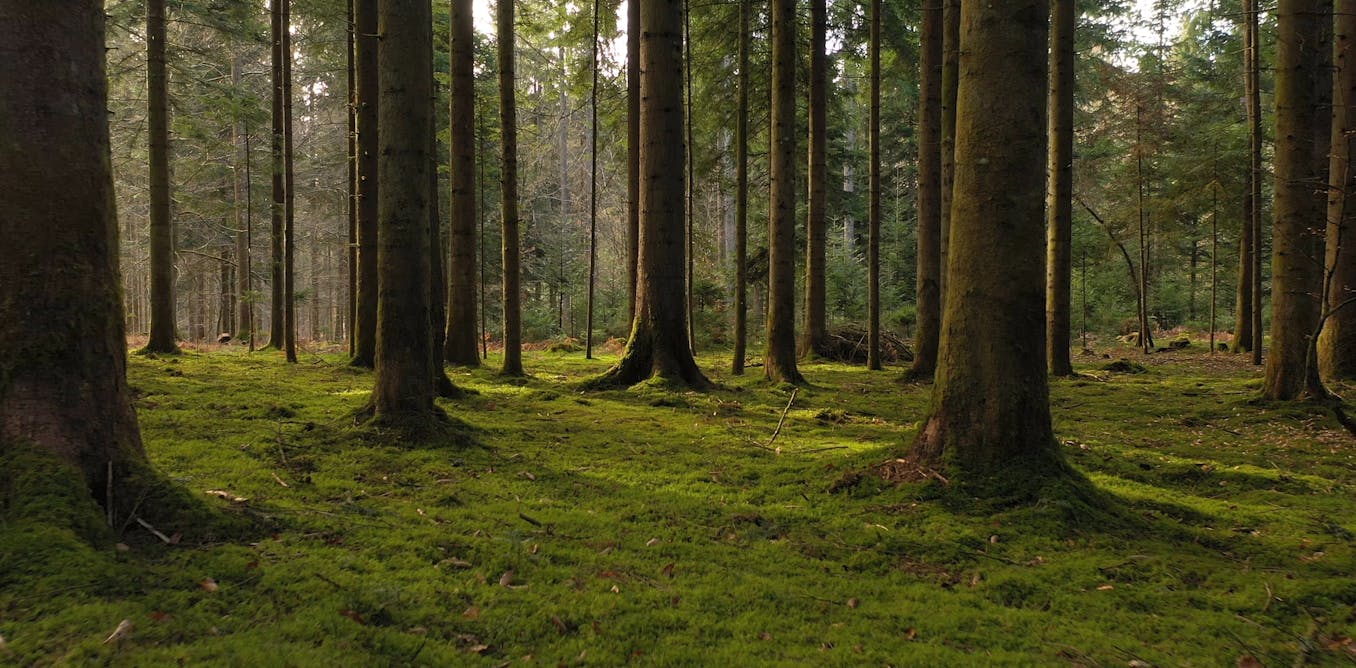 theconversation.com
theconversation.com
But it’s not just humans and other animals who developed sophisticated communication. A lot of people think of plants as passive but they have their own way of interacting with each other. The idea has been around for a while, even inspiring Hollywood movies like Avatar. But recent science is showing plant communication systems may be more complex than we imagined. Recently, scientists discovered just how well-connected plants are and how efficiently they can send messages to their peers via their roots, electrical signals, a network of underground fungi and soil microbes. The nosy plant neighbourhood watch was discovered.
 phys.org
phys.org
Conservationists at Persepolis, Iran's most iconic ancient site, are waging a delicate battle against an unlikely adversary: tiny but persistent lichens eroding the millennia-old monuments. The fight, which began years ago, is aimed at stopping the threat to the integrity of the site's structures and its intricate carvings from lichens, organisms that grow on surfaces like stone and can slowly break them down over time. Built in the 6th century BC by Darius I, Persepolis has withstood destruction, looting, earthquakes, fires and harsh weather. It remains a source of pride for Iranians and a major tourist destination.
 theconversation.com
theconversation.com
Around 252 million years ago, the world suddenly heated up. Over a geologically brief period of tens of thousands of years, 90% of species were wiped out. Even insects, which are rarely touched by such events, suffered catastrophic losses. The Permian-Triassic mass extinction, as it’s known, was the greatest of the “big five” mass extinctions in Earth’s history. Scientists have generally blamed the mass extinction on greenhouse gases released from a vast network of volcanoes which covered much of modern day Siberia in lava. But the volcanic explanation was incomplete. In our new study, we show that an enormous El Niño weather pattern in the world’s major ocean added to climate chaos and led to extinctions spreading across the globe.
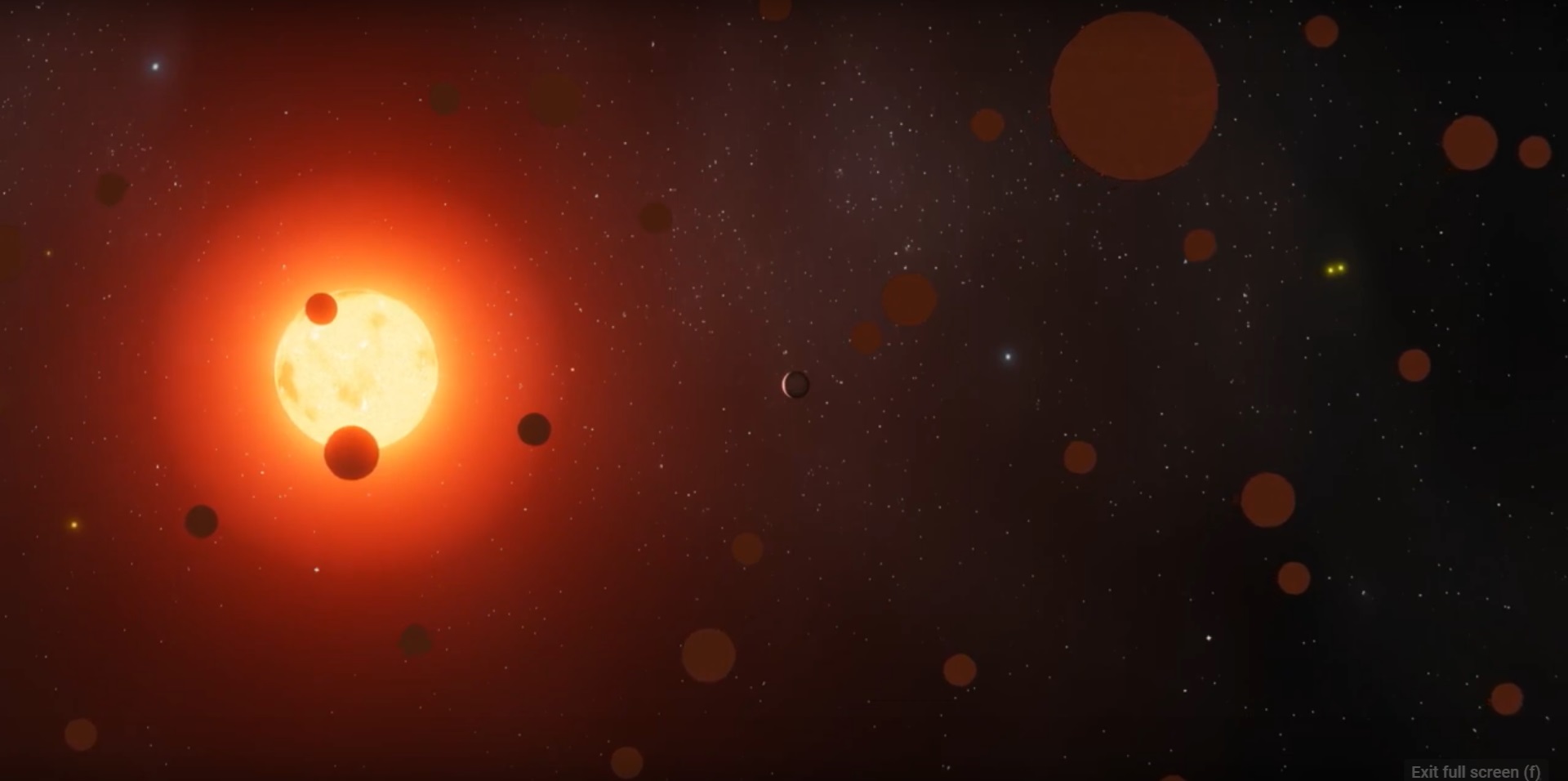 www.universetoday.com
www.universetoday.com
Similar to other proposals involving gram-scale spacecraft and lightsails, the “swarming” concept involves accelerating tiny spacecraft with a laser array to up to 20% the speed of light. As we addressed in previous articles, the Swarming Proxima Centauri concept has evolved significantly over the past few years. The concept emerged in 2017 as a proposal by the i4is named Project Lyra, which aimed to send tiny spacecraft to catch up with the interstellar object (ISO) ‘Oumuamua. However, it has since evolved into a collaborative effort between the i4is and Space Initiatives Inc., a Florida-based aviation and aerospace component manufacturer dedicated to developing gram-based “femtospacecraft” – i.e., even tinier than nanospacecraft! The probes are solid, armored on one side, and covered with optical annuli (reflective material) on the other. They measure about two centimeters thick (0.8 inches) and four meters (about 13 feet) in diameter and weigh no more than a few grams each. According to their NIAC proposal, these will be accelerated by a ~100 gigawatt (GW) laser array that will be available by mid-century. The probes are also equipped with side-mounted lasers to facilitate communications between them and mission controllers back on Earth. **A Flyby of Proxima Centauri, the nearest star.** [https://www.youtube.com/watch?v=aWeno0vIGOE](https://www.youtube.com/watch?v=aWeno0vIGOE)
 phys.org
phys.org
Egyptian temples were not only colorful, but also gleamed in glistening gold. Columns, gates and obelisks have been covered in gold since the beginning of the Pharaonic Period. Researchers also know from textual sources that some of the buildings were gilded. In most cases, these were overlays of thicker metal foils made of gilded copper. Their traces can only be seen today as holes in the walls. The Egyptian restorers removed dust, bird droppings and other deposits, such as soot, from the sandstone reliefs. In the process, the researchers uncovered the remains of the paintwork that once covered the entire reliefs. In most ancient Egyptian temples, painting is not preserved at all, or only in a few (interior) areas. **Facts about the temple of Edfu** In addition to being the best-preserved sanctuary in Egypt, the temple of Horus at Edfu is a marvel of ancient structural design, with a length of 137 meters, a width of 76 meters at the pylon, and heights ranging from 15 meters to 35 meters. With such grand proportions and its wall surfaces completely covered with inscriptions and pictorial reliefs, it also stands as a unique monument of ancient religion and architecture. Built and decorated between 237 and 57 BC, under the reigns of Kings Ptolemy III-XII, it contains more religious texts and ritual scenes than almost any other Egyptian temple, some of which can be traced back to the third millennium BC.
 phys.org
phys.org
At a shelter for big cats in Brazil, a vet gingerly dresses wounds on a jaguar that was caught in wildfires raging in the world's largest tropical wetland. While the animal is expected to heal, her home in the Pantanal continues to burn. The Pantanal, south of the Amazon in Mato Grosso do Sul state, has the world's highest density of jaguars. It is also home to millions of caimans, parrots and giant otters. Brazil has been parched by a historic drought that experts link to climate change and which has sparked what authorities have called a "fire pandemic." So far this year, some 6.7 million hectares (16.6 million acres) have burned in the Brazilian Amazon, amounting to 1.6 percent of the rainforest.
 theconversation.com
theconversation.com
**Tipping point** On one side, more accurate data and a better understanding of the systematic uncertainties in the measurements could return us to the reassuring comfort of the standard model. Out of its past troubles, the model may emerge not only vindicated, but also strengthened, and cosmology will be a science that is both precise and accurate. But if the balance tips the other way, we will be ushered into uncharted territory, where new physics will have to be discovered. This could lead to a major paradigm shift in cosmology, akin to the discovery of the accelerated expansion of the universe in the late 1990s. But on this path we may have to reckon, once and for all, with the nature of dark energy and dark matter, two of the big unsolved mysteries of the universe.
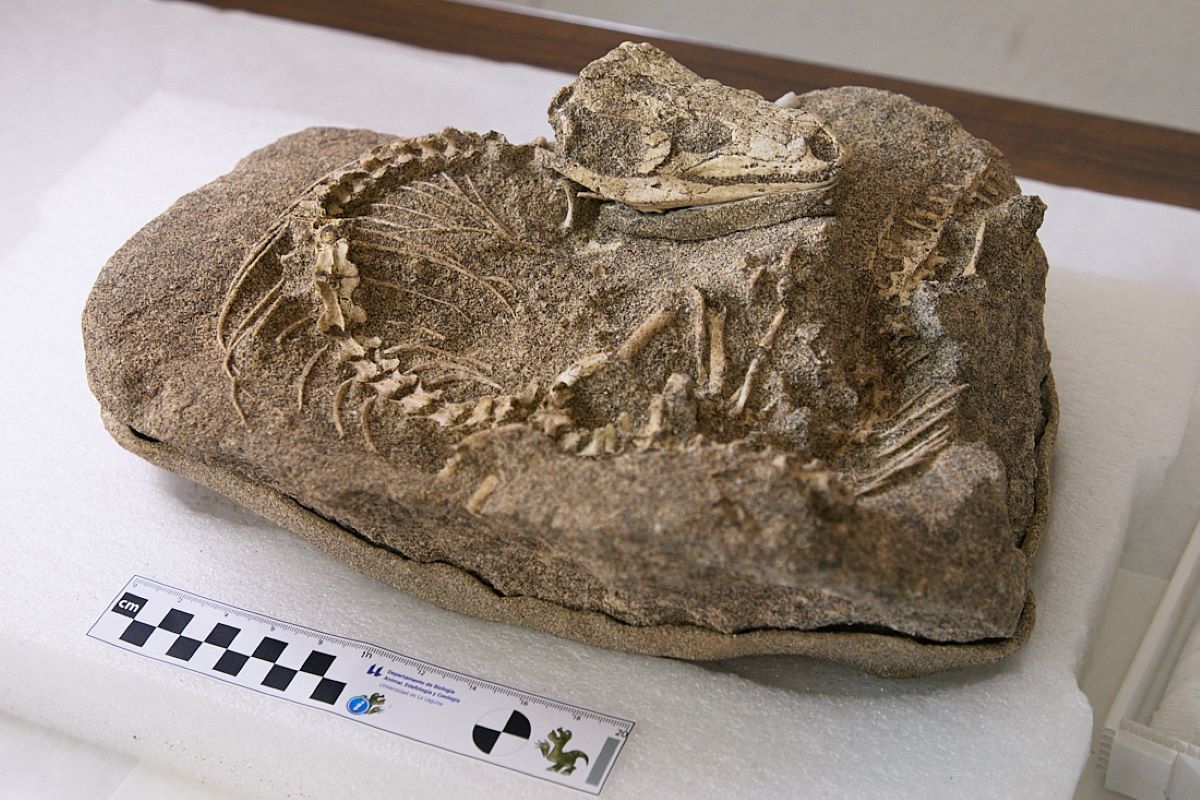 www.newsweek.com
www.newsweek.com
Researchers believe that the specimen might be an example of Gallotia goliath, an extinct species of giant lizard species that lived long before humans reached the Canary Islands. Retired botanist Arnoldo Santos-Guerra stumbled across the remarkably intact lizard fossil two years ago while searching for snail shells. The 42-pound sandstone block containing the specimen also contained a second lizard—one perhaps smaller or just more juvenile—but in a much worse state of preservation. The researchers believe that the two lizards may have perished together in a sand dune. The fact that the larger lizard is so well preserved—with its skeleton in life position rather than scattered in pieces—suggests it likely died and was buried suddenly, protecting it from decay and scavenging.
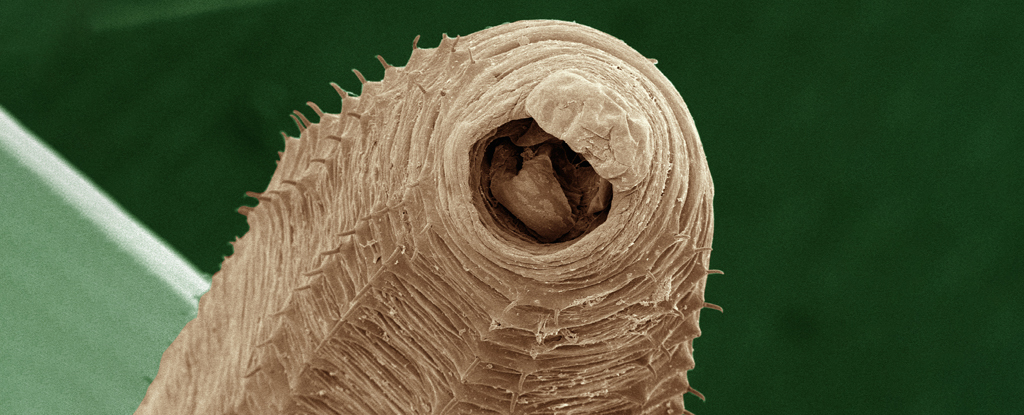 www.sciencealert.com
www.sciencealert.com
Back around when worms wriggled out of saltwater and into freshwater, they experienced a cataclysmic rearrangement of their genetic material. This event ripped once functioning genes asunder, including some of those involved in critical cell division processes, leaving earthworms, leeches, and their other clitellate relatives with the most scrambled genomes known. Three groups of researchers have now independently reached this same conclusion, upending a long held assumption that there's a certain level of genetic stability required for animal species to avoid extinction. Evolutionary biologist Carlos Vargas-Chávez, also from CSIC-UPF, and colleagues discovered gene loss is about 25 percent higher in the line of worms that became clitellata, compared to their other relatives. They suspect the worm's genomes scrambled in response to shifts into new habitats, but have yet to determine which came first, the worm's ventures into freshwater and land or their genes' adventures into new positions in their genetic molecules (chromosomes).
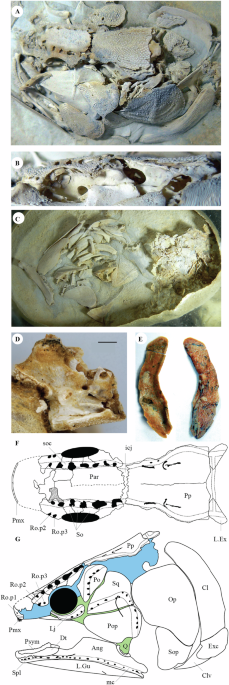 www.nature.com
www.nature.com
The living coelacanth Latimeria (Sarcopterygii: Actinistia) is an iconic, so-called ‘living fossil’ within one of the most apparently morphologically conservative vertebrate groups. We describe a new, 3-D preserved coelacanth from the Late Devonian Gogo Formation in Western Australia. We assemble a comprehensive analysis of the group to assess the phylogeny, evolutionary rates, and morphological disparity of all coelacanths. We reveal a major shift in morphological disparity between Devonian and post-Devonian coelacanths. The newly described fossil fish fills a critical transitional stage in coelacanth disparity and evolution. Since the mid-Cretaceous, discrete character changes (representing major morphological innovations) have essentially ceased, while meristic and continuous characters have continued to evolve within coelacanths. Considering a range of putative environmental drivers, tectonic activity best explains variation in the rates of coelacanth evolution.
A new study posits a very surprising answer to one of history's great mysteries—what killed off the Neanderthals? Could it be that they were unadventurous, insular homebodies who never strayed far enough from home? **Highlights** - We present the discovery of a Neanderthal body and its genome - It is one of the last representatives of these populations in Eurasia - It belongs to an unknown lineage, isolated for 50 ka - It is similar to Gibraltar Neanderthals, with whom it forms a specific branch **Summary** Neanderthal genomes have been recovered from sites across Eurasia, painting an increasingly complex picture of their populations’ structure that mostly indicates that late European Neanderthals belonged to a single metapopulation with no significant evidence of population structure. Here, we report the discovery of a late Neanderthal individual, nicknamed “Thorin,” from Grotte Mandrin in Mediterranean France, and his genome. These dentognathic fossils, including a rare example of distomolars, are associated with a rich archeological record of Neanderthal final technological traditions in this region ∼50–42 thousand years ago. Thorin’s genome reveals a relatively early divergence of ∼105 ka with other late Neanderthals. Thorin belonged to a population with a small group size that showed no genetic introgression with other known late European Neanderthals, revealing some 50 ka of genetic isolation of his lineage despite them living in neighboring regions. These results have important implications for resolving competing hypotheses about causes of the disappearance of the Neanderthals **Was a lack of get-up-and-go the death of the Neanderthals?** [https://phys.org/news/2024-09-lack-death-neanderthals.html](https://phys.org/news/2024-09-lack-death-neanderthals.html)
 www.sciencealert.com
www.sciencealert.com
An experiment here on Earth has just replicated one of the most extreme astrophysical processes in miniature. Physicists at the Princeton Plasma Physics Laboratory (PPPL) have succeeded in creating collimated jets that resemble those that erupt from baby stars and feeding black holes. Our lab version is nowhere near as large or powerful as those in space, which can extend for millions of light-years. But the results have revealed for the first time a long-hypothesized plasma instability that can help us understand how these eruptions form and launch into space at speeds close to that of light.
 phys.org
phys.org
Astronomers from the Nicolaus Copernicus University in Torun have discovered a new planet in the constellation of the Great Bear. It has a mass as much as 11 times that of Jupiter, orbits its star in 14 years and has a temperature of no more than minus 100 degrees Celsius. **An inconspicuous star with a massive planet** The astronomers are dealing with an extremely massive exoplanet—as much as 11 times the mass of Jupiter, the largest planet in our solar system. It orbits its parent star in 14 years, and is six astronomical units away from it. **Tracking Advanced Planetary Systems (TAPAS) with HARPS-N VIII. A wide-orbit planetary companion in the hot-Jupiter system HD 118203** [https://www.aanda.org/articles/aa/full_html/2024/08/aa51084-24/aa51084-24.html](https://www.aanda.org/articles/aa/full_html/2024/08/aa51084-24/aa51084-24.html)
 www.mirror.co.uk
www.mirror.co.uk
Researchers working on the site found the body - which had been buried on a hill - was pressed into the ground by stones laid across its torso. Polish officials added that the child appeared to have been decapitated before it was buried, with the collection of details suggesting superstitious locals had feared the presence of a "demonic entity". One year earlier at the same site, they had uncovered the remains of a woman who had a sickle pressed to her torso, another superstitious rite thought to prevent "vampires" from making an unwelcome return. The remains of the vampire child, archaeologists said, were found alongside those of another child who received a "normal" burial dating from the same period. Mr Wira explained: "Both burials are dated from the Early Middle Ages - 13th century. The dead were buried without coffins." Archaeologists now plan to carry out a selection of tests on the two skeletons so they can determine how old the two children were when they died. The two, they believe, likely aren't the only ones present on the site of the bishop's garden, with others expected to be nearby.
Head of SETI reveals how they search for life in space